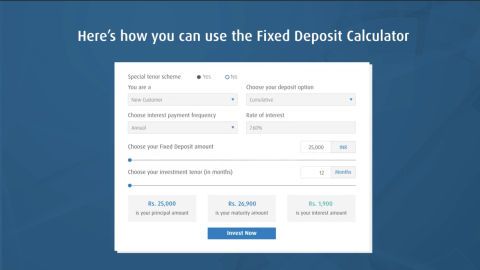The government collects revenue from the citizen of a country in the form of taxes. This revenue is used in providing civic amenities. Citizens are taxed if their annual income exceeds a certain pay bracket. This is known as taxable income.
The government offers certain exemptions in paying taxes, provided you invest in certain schemes. One of the most significant heads under which you can declare your savings and get maximum deductions is Section 80C.
What are tax deductions?
Tax deductions stand for the amount that you can deduct from your taxable income in a single financial year. This reduces your overall obligation and helps you save tax in lieu of your savings. However, the amount that you can claim as a deduction varies based on your income slab, your total savings, and the sections under which you can claim these savings.
The government specifies a list of savings and expenses that you may incur within a year under various slabs with a maximum limit cap corresponding to which you can claim tax deductions.
What are the various sections that offer tax deductions?
The sections under which you can claim tax deductions include 80C, 80D, 80E, 80CCD, 80CCC, 24, 80CCG, 80U, 80G and many more. These sections have separate savings listed under each along with their maximum cap. In case you make payments towards savings or expenses in a given financial year that fall under any of these sections, then you can claim the tax benefits mentioned.
Additional Read: Tax saving investment options
Introduction to Section 80C, 80D, 80E, and 80G
All these sections denote different slabs that help you save on tax. Here’s a snapshot of each.
Section 80C
You can claim tax deductions of up to Rs. 1.5 lakh every year based on the payments and investments you make as an individual or on behalf of a Hindu Undivided Family (HUF). Some of the more relevant investments that are allowed for deduction under this slab are the payments made towards life insurance policies, provident fund, tuition fees of your children (maximum 2), construction or the purchase of a residential property, a tax-saving fixed deposit with a lock-in period of 5 years, investment in mutual funds and savings bonds, etc.
Section 80D
Under this section of the Income Tax Act, you can claim deductions of up to Rs. 25,000 against the premium payments you make on medical insurance for yourself, your spouse and your dependent children. You can also claim an additional deduction for the payment of insurance premiums of your parents to up to Rs. 25,000 if they are less than 60 years of age or Rs. 50,000 in case your parents are above 60 of age. An additional deduction of Rs. 5,000 is also allowed under this section for payments made towards preventive health check-ups. This exemption was brought to action from FY 2015-16.
Additional Read: How much tax can be saved under 80D
Section 80E
Under this section of the Income Tax Act, you can claim deductions made towards the payment of interest on an education loan. You can claim this deduction as long as the loan is used by you, your spouse, your children or someone for whom you are the legal guardian. There is no maximum cap on the interest you can claim with respect to this section. The only restriction is that you can claim deductions up to a maximum of 8 years beginning from the time you start repaying the interest on your loan.
Section 80G
Under this section of the Income Tax Act, you can claim deductions against the various donations you make as specified by the Income Tax department. You can either claim 100% or 50% of what you donate in cash or cheque. Donations in kind such as clothes, food, groceries, etc. are not allowed for deductions. During the latest budget, the government has put a cap on the donations in cash at Rs. 2,000. Apart from this, read on to see how you can save when you donate according to the lists below:
Donations that are allowed 100% deduction without any qualifying limit
- National Defence Fund set up by the Central Government
- Prime Minister’s National Relief Fund
- National Foundation for Communal Harmony
- An approved university/educational institution of National eminence
- Zila Saksharta Samiti constituted in any district under the chairmanship of the Collector of that district
- Fund set up by a State Government for the medical relief to the poor
- National Illness Assistance Fund
- National Blood Transfusion Council or to any State Blood Transfusion Council
- National Trust for Welfare of Persons with Autism, Cerebral Palsy, Mental Retardation and Multiple Disabilities
- National Sports Fund
- National Cultural Fund
- Fund for Technology Development and Application
- National Children’s Fund
- Chief Minister’s Relief Fund or Lieutenant Governor’s Relief Fund with respect to any State or Union Territory
- The Army Central Welfare Fund or the Indian Naval Benevolent Fund or the Air Force Central Welfare Fund, Andhra Pradesh Chief Minister’s Cyclone Relief Fund, 1996
- Chief Minister’s Earthquake Relief Fund, Maharashtra
- The Maharashtra Chief Minister’s Relief Fund during October 1, 1993 and October 6,1993
- Chief Minister’s Earthquake Relief Fund, Maharashtra
- Any fund set up by the State Government of Gujarat exclusively for providing relief to the victims of earthquake in Gujarat
- Any trust, institution or fund to which Section 80G(5C) applies for providing relief to the victims of earthquake in Gujarat (contribution made during January 26, 2001 and September 30, 2001) or
- Prime Minister’s Armenia Earthquake Relief Fund
- Africa (Public Contributions — India) Fund
- Swachh Bharat Kosh
- Clean Ganga Fund
- National Fund for Control of Drug Abuse
Donations allowed for 50% deduction without any qualifying limit
- Jawaharlal Nehru Memorial Fund
- Prime Minister’s Drought Relief Fund
- Indira Gandhi Memorial Trust
- The Rajiv Gandhi Foundation
Donations allowed for 100% deduction subject to 10% of adjusted gross total income
- Government or any approved local authority, institution or association to be utilised for the purpose of promoting family planning
- Donation by a Company to the Indian Olympic Association or to any other notified association or institution established in India for the development of infrastructure for sports and games in India or the sponsorship of sports and games in India
Donations allowed for 50% deduction subject to 10% of adjusted gross total income
- Any other fund or any institution which satisfies conditions mentioned in Section 80G(5)
- Government or any local authority to be utilised for any charitable purpose other than the purpose of promoting family planning
- Any authority constituted in India for the purpose of dealing with and satisfying the need for housing accommodation or for the purpose of planning, development or improvement of cities, towns, villages or both
- Any corporation referred in Section 10(26BB) for promoting interest of minority community
- For repairs or renovation of any notified temple, mosque, gurudwara, church or other place
What investments should you make to save tax under Section 80C?
The Income Tax department in India has drafted a list mentioning all the categories and sub-categories under which you can save to claim deductions under Section 80C. The categories for investment are listed below.
Additional Read: Tax saving investment under Section 80c
- Life insurance premium for policy for yourself, your spouse and any dependent child. In case of HUF, on life of any member of the HUF.
- Contributions made under Employees' Provident Fund Scheme.
- Contribution to Public Provident Fund Account in the name of – self, spouse or any child. In case of HUF, any member of HUF.
- Contribution by an employee to a recognised provident fund.
- Contribution by an employee to an approved superannuation fund.
- Subscription to any notified security or notified deposit scheme of the Central Government. For this purpose, Sukanya Samriddhi Account Scheme has been notified vide Notification No. 9/2015, dated 21.01.2015. Any sum deposited during the year in Sukanya Samriddhi Account by an individual would be eligible for deduction.
- Amount you deposit in your name or in the name of a girl child who is your daughter or for whom you are the legal guardian.
- Subscription to notified savings certificates (National Savings Certificates (VIII Issue)).
- Contribution for participation in unit-linked Insurance Plan of UTI in the name of – self, spouse or any child. In case of HUF, any member of HUF.
- Subscription to notified deposit scheme or notified pension fund set up by National Housing Bank (Home Loan Account Scheme/National Housing Banks (Tax Saving) Term Deposit Scheme, 2008).
- Payment made towards notified annuity plan of LIC (New Jeevan Dhara/New Jeevan Dhara-I/New Jeevan Akshay/New Jeevan Akshay-I/New Jeevan Akshay-II/Jeewan Akshay-III plan of LIC) or another insurer.
- Subscription to any units of any notified (u/s 10(23D)) Mutual Fund or the UTI (Equity Linked Saving Scheme, 2005).
- Contribution by an individual to any pension fund set up by any mutual fund which is referred to in section 10(23D) or by the UTI (UTI Retirement Benefit Pension Fund).
- Subscription to equity shares or debentures forming part of any approved eligible issue of capital made by a public company or public financial institutions.
- Subscription to any units of any approved mutual fund referred to in section 10(23D), provided amount of subscription to such units is subscribed only in 'eligible issue of capital' referred to above.
- Term deposits with a lock-in period of at least 5 years with a scheduled bank, and which is in accordance with Scheme 11.
- Subscription to notified bonds issued by the NABARD.
- Deposit in an account under the Senior Citizen Savings Scheme Rules, 2004 (subject to certain conditions).
Here is the list of investments that qualify for income tax deductions under Section 80C:
| Investments Under Section 80C | Tax Deductions |
| Fixed Deposit | Interest earned is taxable |
| Public Provident Fund | Interest earned is tax-free |
| Employee Provident Fund | Entire PF balance (including interest) is tax-free |
| National Pension System | Employer contributions are tax-free |
| Unit linked Insurance Plans | Investment and withdrawals & maturity amount are tax-free |
| Sukanya Samriddhi Yojana | Investment and withdrawals & maturity amount are tax-free |
Additional Read: Short term investment plans with high returns
What expenses qualify for tax deductions under Section 80C?
Apart from the investments mentioned above, the Income Tax department also specifies a few expenses for which you are allowed to claim deduction under 80C. Here is the list of the expenses.
- Expenses deducted from salary payable to government servant for securing deferred annuity or making provision for wife/ children (the qualifying amount is limited to 20% of your salary).
- Amount paid as tuition fees (excluding development fees, donations to educational institutes, etc.) to any university, college, school or other educational institution in India for full-time education of up to 2 children.
- Payments made in for overhead cost, stamp duty and registration for the purchase or construction of residential property.
- Getting certain schemes or home loan from a. public sector companies engaged in providing long-term finance for purchase/ construction of houses in India for residential purposes and authority constituted under any law for satisfying need for housing accommodation or for planning, development or improvement of cities, towns and villages, or for both. The principal repayment as expenses towards these schemes or your housing loan is allowed for deduction under 80C.
How much tax can you save under Section 80C, 80D, and 80G?
Under Section 80C of the Income Tax Act, you can claim deductions of up to Rs. 1.5 lakh annually based on the investments and expenses you make in tune with this section mandates. Regardless of the 80C deduction, you can also claim up to Rs. 1 lakh instead of the payment made towards your health insurance premiums for you and your family, including dependent children and senior citizen parents.
You can also claim separate deductions under Section 80G over and above the 80C deductions. Here, you can claim 100% or 50% of the amount you have paid as donations to the categories listed above. There is no cap on the upper limit for your claim as long as you pay by cheque, but for cash payments it is capped to Rs. 2,000. So, in total, you can avail a deduction of more than Rs. 2 lakh by making investments and expenses cited under these sections.
This means that based on your cumulative deduction amount your taxable income will reduce based on your income slab. Then your payable tax will be calculated on this reduced amount.
What is Form-16 and why is it important?
A Form 16 is a certificate that your employer issues to you which works as a proof of your annual TDS or tax deducted at source. This document is vital as it not only shows that your employer has made deposits of tax on your behalf to the Income Tax department, but it also gives a break-up of your annual salary and all your investments and expenses.
Basically, the Form 16 is highly important as it works as a unified document using which you can file your taxes for the financial year for which you receive the Form 16.
Your employer is likely to issue a Form 16 to you on or before 15th June of the next year for the preceding financial year. Your Form 16 will essentially have two parts: While Part A gives background information of both you and your employer, Part B enlists your salary break-up and all the other Sections under which you have claimed deductions for investments and expenses.
Additional Read: Difference between Form 16 and 16a
Filing timely taxes saves you a lot of future hassles, so plan ahead and invest judiciously under the above-mentioned sections to claim the maximum tax benefits on your income.
DISCLAIMER:
While care is taken to update the information, products, and services included in or available on our website and related platforms/websites, there may be inadvertent inaccuracies or typographical errors or delays in updating the information. The material contained in this site, and on associated web pages, is for reference and general information purpose and the details mentioned in the respective product/service document shall prevail in case of any inconsistency. Subscribers and users should seek professional advice before acting on the basis of the information contained herein. Please take an informed decision with respect to any product or service after going through the relevant product/service document and applicable terms and conditions. In case any inconsistencies observed, please click on reach us.
*Terms and conditions apply








